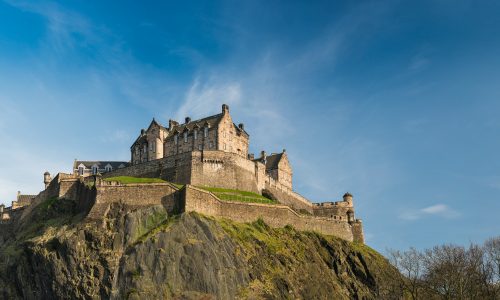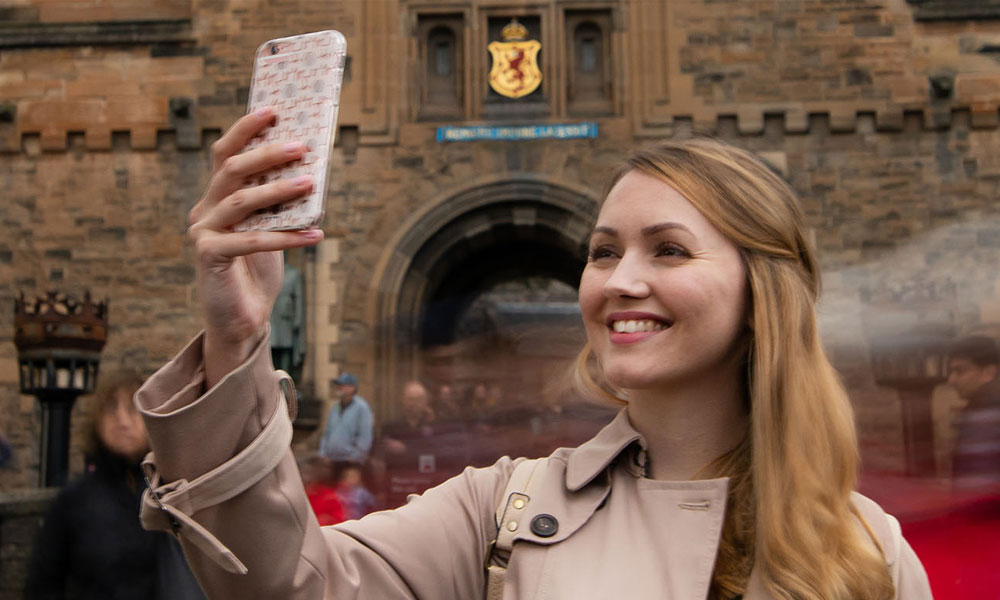
A virtual tour with us!
2 February 2021
Whilst we are staying at home, we wanted to bring the castle straight to the comfort of your living room. We can’t wait to re-open our gates and welcome you back through them. Until then, we have put together a selection of our wonderful 360 views of the castle as a virtual tour.
Right, all there’s left to do is, grab a cuppa, get comfy and let’s go!
Arriving at the castle
As we are all staying home and staying safe that doesn’t mean we can’t bring the castle to you. We have a fantastic…
Posted by Edinburgh Castle on Wednesday, April 8, 2020
We start by walking up the castle Esplanade and approach the drawbridge and Gatehouse. The Gatehouse was built in 1888 with the sole intention of making the castle look more imposing. It replaced a much simpler gate of the 1600s. Outside set into the façade, are bronze statues of King Robert the Bruce on the left and Sir William Wallace on the right.
The Portcullis Gate and The Argyle Battery
Are you ready for another 360° tour of the castle this Wednesday? We know we are! Stay home and enjoy!
Once you enter…
Posted by Edinburgh Castle on Wednesday, April 15, 2020
Once you enter the Portcullis Gate, to the left of you is a steep flight of 70 steps aptly named The Lang Stairs, once the main route to the summit in medieval times. The stairs once passed beneath the tall Constable’s Tower, which was destroyed during the Lang Siege. The curved wall on the right of the stairs may have formed part of the tower.
Straight in front of you, you are greeted by the Argyle Battery. This six – gun artillery was built in the 1730s. It was named after the 2nd Duke of Argyll, commander of an army that halted the advance of a much larger Jacobite force at Sheriffmuir in 1715.
The Argyle Battery is the perfect viewpoint to take in the breath-taking city vistas to the north, north-east and north- west of Edinburgh. From here you can see the New Town, Leith, The Forth of Firth and even right across to Fife.
To the left of the Argyle Battery is the One o’clock Gun, It can be heard across the city and well out to the Forth of Firth, this is significant as the gun was originally introduced as an aid to shipping. In order to navigate accurately, a ship’s crew need to know the exact time, calibrating it with the position of the Sun. And in 1861 the One o’clock Gun was introduced.
Foogs Gate
It’s Wednesday and it’s time to take in the sights of the castle.
This is Foogs Gate which was built in the later…
Posted by Edinburgh Castle on Wednesday, April 22, 2020
This is Foogs Gate which was built in the later 1600s, during a major refortification of the castle commissioned by King Charles II. The origin of the name is unknown. It was previously known as ‘Foggy Gate’ referring the perhaps the haar – a thick sea mist that shrouds the Castle Rock from time to time. The walls on both sides of the gate having openings for cannons and muskets.
The oldest building in the castle
It’s Wednesday and that can only mean one thing! Let’s take a virtual tour of the castle – who’s coming?
This beautiful…
Posted by Edinburgh Castle on Wednesday, April 29, 2020
This beautiful building is St Margaret’s Chapel, the oldest building in the castle and Edinburgh. It was built around 1130 by King David I as a private royal chapel. He dedicated it to his mother, Queen Margaret, later St Margaret. The chapel was probably part of the first stone-built royal lodging in the castle, housing a hall and private chambers.
Well, well, well!
Next up on our 360 tour this week is the Fore Well and The Scottish National War Memorial.
The Fore Well first…
Posted by Edinburgh Castle on Wednesday, May 27, 2020
The Fore Well first appeared in historic records in 1314, when it was deliberately blocked by Robert the Bruce’s troops as part of wider destruction of the castle to prevent it being used against them, but it is thought to be older. In its long history, the well has provided a vital lifeline to the castle’s residents throughout many sieges.
Fantastic city views
Are you ready for another tour of the castle this Wednesday? We are! Come with us as we explore this hidden gem!
This…
Posted by Edinburgh Castle on Wednesday, May 6, 2020
This is the Western Viewpoint – situated in Hospital Square. Amazing views to the west of Edinburgh are all yours from this high rampart. On clear days, even distant Highland peaks are part of the picture – they’re most visible when capped with snow.
The famous siege cannon – Mons Meg
Good Morning! It’s Wednesday, are you ready for a 360 tour of the castle?
Weighing six tonnes with a bore of 19in…
Posted by Edinburgh Castle on Wednesday, May 13, 2020
Weighing six tonnes with a bore of 19in (48cm) Mons Meg is possibly the largest gun ever fired in anger in Britain. In 1449, when the bombard (siege cannon) was forged in the Belgian Town of Mons, she was cutting-edge military technology. She could fire a stone ball almost two miles (3.2km).
Meg’s last salute came in 1681, when she was fired to mark the birthday of the Duke of Albany – later King James VII. A charge of particularly potent gunpowder burst her barrel – you can still see the damage. Mons Meg was then unceremoniously dumped within the castle and lay neglected for many years. In 1754, Mons Meg was taken to the Tower of London, long with other inoperative guns, in the wake of the Jacobite Risings. But she was not forgotten.
In the 1820s, campaigns were launched to have this icon of Scotland’s heritage returned. On 9 March 1829, Mons Meg was given a military escort back to the castle through crowding cheers. The grand old lady had finally come home.
Hospital Square
Who’s ready for a tour of the castle on a glorious sunny day!
Today’s tour takes us to Hospital Square, which was named…
Posted by Edinburgh Castle on Wednesday, May 20, 2020
Hospital Square was named after the military hospital that once stood here. It was built in 1897 where sick and wounded soldiers were cared for. Today this is home to the National War Museum. The museum’s outstanding collection presents the story of Scots at war from the creation of the first standing army in the 1600s to the present day.
In the courtyard is the fine equestrian statue of Field Marshal Earl Haig, gifted to the city in 1923 by Sir Dhunjibhoy Bomanji of Bombay. The statue had stood on the castle esplanade for almost 90 years.
Crown Square
To get you all in the Friday spirit we are going on another tour of the castle. This time we are heading to the very top…
Posted by Edinburgh Castle on Friday, April 17, 2020
And where better to end our castle tour then at the very top in Crown Square.
Crown Square was created in the later 1400s as the principal courtyard of the castle. It was originally known as the Palace Yard. During the long period of military use in the 1600s and 1700s, it had been known as the Grand Parade. The name ‘Crown Square’ came into use after Walter Scott’s discovery of the Scottish Crown Jewels and the other royal regalia in the Royal Palace in 1818.
We hope you enjoyed our virtual castle tour. For more history and castle images follow us on Facebook, Instagram and Twitter
